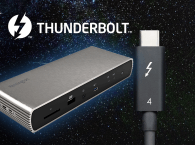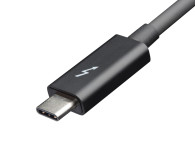
Apple introduced its “thinnest and lightest MacBook Pro ever,” along with a breakthrough interface that replaces the traditional row of function keys with a brilliant, Retina-quality Multi-Touch display called the Touch Bar. The new MacBook Pro generation, with three new models to choose from, also features Apple’s brightest and most colorful Retina display yet, the security and convenience of Touch ID, a more responsive keyboard, a larger Force Touch trackpad and an audio system with double the dynamic range. It’s also the most powerful MacBook Pro ever, featuring sixth-generation quad-core and dual-core processors, up to 2.3 times the graphics performance over the previous generation, super-fast SSDs and up to four Thunderbolt 3 ports.
The Touch Bar adapts when using the system or apps like Mail, Finder, Calendar, Numbers, GarageBand, Final Cut Pro X (which also received a welcomed update) and many more, including third-party apps from Adobe (Photoshop) or Microsoft (Office). The Touch Bar was demoed with a Djing app, providing a way to select tracks and samples, access cues, and scrub audio, showing that it will enable a completely new style of interaction with a laptop, turning the expanded Force Touch trackpad and Touch Bar into a new-generation control surface.
Those are not small engineering innovations, but the reaction to the new MacBook Pro’s, especially from the professional and creative community now desperate for new workstation-class iMacs and Mac Pros, was less then enthusiastic, even though they obviously welcomed the introduction of Thunderbolt 3 ports, allowing the new laptops - “the most advanced notebook ever made” - to drive up to two external 5K displays, and effortlessly edit 4K video with files stored on an external Thunderbolt 3 RAID storage unit.

And yes, the new MacBook Pros are even lighter, thinner, stronger, and the battery lasts longer. The problem is, they use sixth generation Intel Skylake processors - some of which have been introduced in 2015 - optimized for low-power, and that’s the reason why they cannot work with more than 16GB of RAM. The Skylake quad-core processors used in the new 15-inch MacBook Pro have 16 PCI-e lanes, allowing for the use of four fully-featured Thunderbolt 3 ports, while the processors used on the 13-inch models (with and without Touch Bar) only have 12, allowing only two fully-featured Thunderbolt 3 ports on the left-hand side - the other two ports still provide full Thunderbolt 3 functionality, but have reduced bandwidth, while the left pair retains full PCIe throughput.
Apparently, Intel is still not ready to supply their seventh generation quad-core Kaby Lake processors before 2017, meaning that we will all be forced to wait for the new generation iMac, Mac Minis and Mac Pros with Thunderbolt 3, now long overdue. But that’s also the same reason why Microsoft was forced to announce its Surface Studio all-in-on computer using also Intel Skylake processors and that machine is supposed to be available only in mid 2017, when Apple will be able to launch the new updated iMacs. And Microsoft’s iMac-competitor doesn’t even support Thunderbolt 3 (or USB-C for all that matter) making the Surface Studio an obsolete PC before it’s even available…
 And for simple laptops, the new MacBook Pro are still incredibly powerful machines and they should make anyone in need of a replacement or a new portable machine quite happy. The screen is amazing, the internal graphics are the fastest ever on a laptop, and the internal Flash storage running macOS Sierra operating system make these machines a dream to work with. Still, the really important news the industry was waiting to hear from Apple is: “no, we are not going to be content using USB-C SuperSpeed 10Gbps (USB 3.1 Gen2) only on Mac computers. We are going to go all the way to faster Thunderbolt 3, which is USB compatible (from USB 2.0 all the way to USB 3.1 Gen2), supports 40Gbps bidirectionally on a single USB Type-C cable and is HDMI, DisplayPort, Ethernet and everything else-compatible.
And for simple laptops, the new MacBook Pro are still incredibly powerful machines and they should make anyone in need of a replacement or a new portable machine quite happy. The screen is amazing, the internal graphics are the fastest ever on a laptop, and the internal Flash storage running macOS Sierra operating system make these machines a dream to work with. Still, the really important news the industry was waiting to hear from Apple is: “no, we are not going to be content using USB-C SuperSpeed 10Gbps (USB 3.1 Gen2) only on Mac computers. We are going to go all the way to faster Thunderbolt 3, which is USB compatible (from USB 2.0 all the way to USB 3.1 Gen2), supports 40Gbps bidirectionally on a single USB Type-C cable and is HDMI, DisplayPort, Ethernet and everything else-compatible.The problem now, is how to educate the less-informed consumer about how Thunderbolt 3 and USB-C works, explaining that, “no, you don’t connect a series of dongles to the laptop,” when they just need to connect one single Thunderbolt 3 cable to supply power to the computer, since we can daisy-chain up to six devices on a single cable. And that power and cable will be probably connected to a “hub” or “bridge” type device, which will provide plenty of connectors for legacy products, and might even be an external monitor or storage bay… And yes, we can still have the MagSafe-type connector on that port from Griffin - its just called BreakSafe.
Also, users will need to know that Thunderbolt 3 cables can run slightly longer (2 meters or 6.5 feet) than standard USB-C cables (less than 1 meter or 3 feet). To understand the difference between Thunderbolt 3 and simple USB-C cable, apart from the length, they will have to learn the symbols that distinguishes both types, with the “lightning” symbol used on Thunderbolt 3 and the USB trident, or three-pronged spear, used on USB-C only cables and connectors (adding the battery symbol for power-delivery). It will be a long learning curve…
New with Thunderbolt 3
Meanwhile, since the whole Intel USB-C and Thunderbolt 3 specifications were available since late 2015, early 2016, and all IT and CE manufacturers were basically waiting for an Apple announcement to be fully confident of the way forward, the October 26 announcement triggered a series of announcements of products which had been seen in final stages at CES 2016 (January 2016). One of those products was featured during Apple’s MacBook announcement and was probably the only one no one knew about.
That was about LG Electronics’ new UltraFine 5K/4K displays. The two new 27 and 21.5-Inch displays were designed specifically to integrate seamlessly with the new MacBook and MacBook Pro models and for for creating an expanded work space in the home or office. Designed and optimized for Thunderbolt 3, the 27-inch UltraFine 5K monitor features a breathtaking resolution of 5120 x 2880 and 218 pixels per inch (ppi), with P3 color space. The monitor’s advanced IPS display technology minimizes color shift and color loss from any viewing angle. Only the frame looks black and ugly, not at all like an Apple display…

As the world's first 5K display with Thunderbolt 3, the LG UltraFine 5K display has the capability to receive and transfer 5K video, audio and data, while simultaneously charging external computers through a single Thunderbolt 3 cable. The LG UltraFine 5K display features three downstream USB Type-C ports for additional connectivity and power with compatible accessories. Seamless macOS integration enables brightness and volume control like built-in display without the need for physical buttons on the display. It also features a front-facing camera, microphone and high fidelity integrated speakers.
With sharp 4K resolution (4096 x 2304) image quality and a density of 219 ppi, the smaller 21.5-Inch LG UltraFine 4K monitor also covers 99 percent of the P3 spectrum, boasting vibrant brightness levels from an IPS panel capable of providing more uniform color expression. Featuring USB Type-C connectivity for video, data and power over a single cable and macOS integration for display control, the LG UltraFine 4K display offers three downstream USB Type-C slots, a high-quality speaker and an adjustable stand for enhanced ergonomics. The 21.5-inch LG UltraFine 4K model will be available starting in November and the 27-inch LG UltraFine 5K model will be available in early December at Apple Stores in the United States.
On the storage front, most brands were also ready to introduce new Thunderbolt 3 external drives and RAID units. After all, using extremely fast storage solutions is now the main reason to upgrade to Thunderbolt 3 solutions, since most of the computers now only use Flash memory storage or SSD drives internally - which are extremely fast, allow faster boot times but are more expensive and have limited capacities. Many of the storage manufacturers have been selling Thunderbolt 1 and 2 solutions for the professional production market for quite some time and those same units can now be used with Thunderbolt 3 computers, using a simple adaptor already available. Still, those units will work at 10 and 20Gbps data rates, of course.

Among the many Thunderbolt 3 ready drives, LaCie was among the first brands to make an announcement. LaCie, a Seagate brand, announced a complete Thunderbolt 3 portfolio of storage solutions, starting with the LaCie Bolt3 desktop drive that combines Thunderbolt 3 speed with the latest M.2 PCIe SSDs. In addition, LaCie announced the 12big Thunderbolt 3 and 6big Thunderbolt 3 RAID 5/6 enterprise-class drives. With design by Neil Poulton, the amazing Bolt3, using two M.2 PCIe SSDs striped into a 2TB volume and delivering record speeds of up to 2800MB/s will be probably a favorite among audio and video production professionals. The LaCie Bolt3 chassis is machined from solid aluminum blocks for rigid durability and heat dissipation and sells for $1999.00. The new the LaCie 12big, with up to 120TB of massive capacity starts at $6399.00 for 48 Terabytes, and the new LaCie 6big will come in 24TB, 36TB, 48TB and 60TB capacities starting at $3199.00. These two new LaCie RAID drives feature Seagate enterprise-class drives with 256MB cache and 7200RPM and all three are able to power computers and monitors, and support USB 3.0 computers via the included USB-C to USB-A cable.
Also targeting professional applications, ATTO Technology announced its plan to support Thunderbolt 3 with a comprehensive line of Apple approved devices, beginning with Thunderbolt 3 to 40Gb Ethernet, 10Gb Ethernet, 32Gb Fibre Channel and 16Gb Fibre Channel adaptors. Featuring already a complete portfolio of low-profile Thunderbolt 2 to 10GbE, Fibre Channel, SAS/SATA and SAS RAID devices, ATTO provides a full line of Thunderbolt 2 devices for storage and network connectivity and will now introduce Thunderbolt 3 support in all its ThunderStream and ThunderLink products.

G-Technology, a Western Digital brand, also announced its new G-Drive lineup of portable solutions using Solid State Technology and USB-C connectivity. The new G-Drive portfolio, with its first solid state portable drive, the G-DRIVE slim SSD USB-C is not Thunderbolt 3, but allows a faster storage solution for mobile applications, available in 1TB and 500GB capacities. It features 10Gb/s (USB 3.1 Gen 2 interface), taking full advantage of the SSD performance and requires no external power source. The MSRP for the 500GB capacity is $229.95 and the 1TB is $379.95.
How to connect everything
Undoubtedly, given the need to interconnect existing equipment, the most popular Thunderbolt 3 solutions will be docking and bridge solutions. Immediately following Apple’s MacBook Pro event, Belkin announced the introduction of its Thunderbolt 3 Express Dock HD.

The Thunderbolt 3 Express Dock HD plugs into devices with a Thunderbolt 3 (USB-C) port supporting 40 Gbps data transfer rates, and 85 Watts of power delivery. From that single Thunderbolt 3 connection to the computer, the dock is able to connect up to five Thunderbolt devices from the dock in daisy-chain from the other Thunderbolt 3 port, including dual 4K video or single 5K outputs for monitors. And the dock also includes three USB-A 3.0 ports (1.5A charging each), one DisplayPort, one audio In/Out port, one Audio Out port, and one Gigabit Ethernet port. The Thunderbolt 3 Express Dock HD includes a 170W power adapter to support attached peripherals and the computer.
At the same time, Belkin also introduced its USB-C to HDMI Adapter featuring up to 4K resolution at 60Hz and two Thunderbolt 3 cables, 0.5m and 2m, supporting up to 40 Gbps data transfer rates.
www.lg.com | www.lacie.com | www.atto.com | www.g-technology.com | www.belkin.com
www.apple.com










